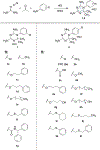Expanding the Landscape of Dual Action Antifolate Antibacterials through 2,4-Diamino-1,6-dihydro-1,3,5-triazines
- PMID: 39950956
- PMCID: PMC11908892
- DOI: 10.1021/acsinfecdis.4c00768
Expanding the Landscape of Dual Action Antifolate Antibacterials through 2,4-Diamino-1,6-dihydro-1,3,5-triazines
Abstract
Antibiotics that operate via multiple mechanisms of action are a promising strategy to combat growing resistance. Previous studies have shown that dual action antifolates formed from a pyrroloquinazolinediamine core can inhibit the growth of bacterial pathogens without developing resistance. In this work, we expand the scope of dual action antifolates by repurposing the 2,4-diamino-1,6-dihydro-1,3,5-triazine (DADHT) cycloguanil scaffold to a variety of derivatives designed to inhibit dihydrofolate reductase (DHFR) and disrupt bacterial membranes. Dual mechanism DADHTs have activity against a variety of target pathogens, including Mycobacterium tuberculosis, Mycobacterium abscessus, and Pseudomonas aeruginosa, among other ESKAPEE organisms. Through X-ray crystallography, we confirmed engagement of the Escherichia coli DHFR target and found that some DADHTs stabilize a previously unobserved conformation of the enzyme but, broadly, bind in the occluded conformation. Using in vitro inhibition of purified E. coli and Staphylococcus aureus DHFR and disruption of E. coli membranes, we determined that alkyl substitution of dihydrotriazine at the 6-position best optimizes the DADHT's two mechanisms of action. By employing both mechanisms, the DADHT spectrum of activity was extended beyond the scope of traditional antifolates. We are optimistic that the dual mechanism approach, particularly through the action of antifolates, offers a unique means of combating hard-to-treat bacterial infections.
Keywords: antibiotic; antifolate; dihydrofolate reductase; dual mechanism; membrane disruption; triazine.
Conflict of interest statement
Notes
The authors declare no competing financial interest.
Figures







References
-
- Wiedemann I; Breukink E; Van Kraaij C; Kuipers OP; Bierbaum G; De Kruijff B; Sahl H-G Specific Binding of Nisin to the Peptidoglycan Precursor Lipid II Combines Pore Formation and Inhibition of Cell Wall Biosynthesis for Potent Antibiotic Activity. J. Biol. Chem 2001, 276 (3), 1772–1779. 10.1074/jbc.M006770200. - DOI - PubMed
-
- Limbrick EM; Graf M; Derewacz DK; Nguyen F; Spraggins JM; Wieland M; Ynigez-Gutierrez AE; Reisman BJ; Zinshteyn B; McCulloch KM; Iverson TM; Green R; Wilson DN; Bachmann BO Bifunctional Nitrone-Conjugated Secondary Metabolite Targeting the Ribosome. J. Am. Chem. Soc 2020, 142 (43), 18369–18377. 10.1021/jacs.0c04675. - DOI - PMC - PubMed
MeSH terms
Substances
Grants and funding
LinkOut - more resources
Full Text Sources
Medical
Molecular Biology Databases

